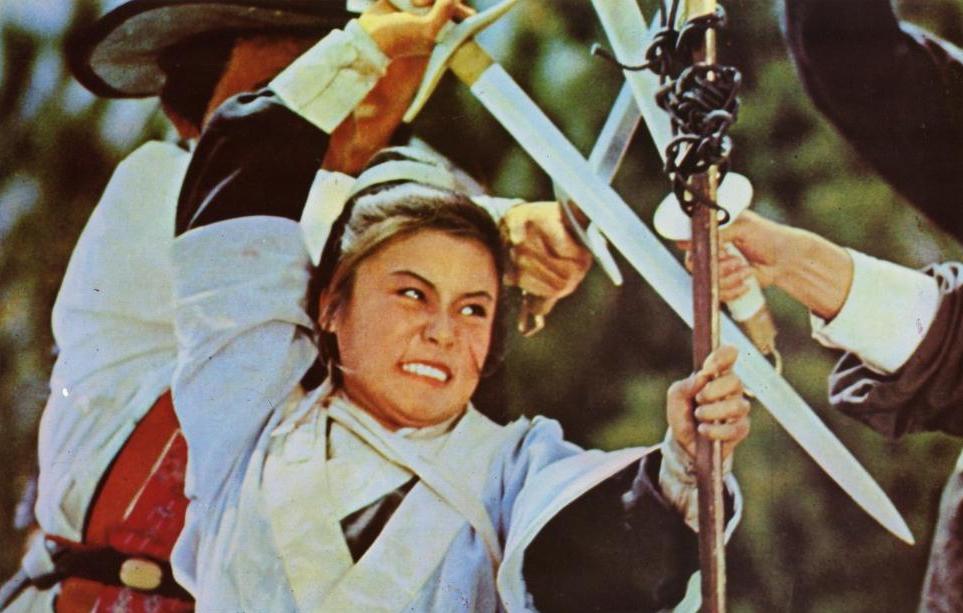Move over, “Kill Bill” and “Enter the Dragon”; there’s a new, cool, martial-arts-kid on the block, and his name is “Dragon Inn.” Well, it’s not quite new – it was first released in Taiwan in 1967, and is just this year being re-released in America by Janus Films in a fabulous 4K restoration. (No badly-dubbed ventriloquism or scratched-up scumminess to be found here. Tarantino must be crying his eyes out.) “Dragon Inn,” nevertheless, is an eyebrow-raising revelation in a year chock full of re-released movie revelations (the Studio Ghibli “Only Yesterday,” Welles’ “Chimes at Midnight”). If the action movie was a fruit, and if you squeezed it into a crystal-clear glass, the juice would taste something like “Dragon Inn” – clean, free of frills and pulp, pure, popping with a punchy and genuine tang.
“Dragon Inn” is basically a sword fight at the O.K. Corral. A band of empirical dissidents, led by the wicked Cao (Bai Ying), have killed high-ranking General Yu in a bold political move. The general’s kids are fleeing west out of China to escape the turmoil. They will be passing by the titular Dragon Gate Inn within a few days, so the ruthless men arrive there early and plan an ambush. They expect it will be an easy and clean kill. But they don’t expect to come face-to-face with the highly deadly friends of the late General Yu, including the inn’s crafty owner, Hsaio the proto-Han Solo beast skilled in the art of the sword (Shi Jun) and a Princess Leia-like sister who makes men whimper at the sight of her (Shangguan Linfeng).
“Dragon Inn” is one of the most rigorously composed, edited and active things I’ve ever laid eyes on. Everything is built from dynamic opposites. Black-white, stasis-motion, bad-good, masculine-feminine –these poles neatly nest within each other. The result impresses upon us a view of a perfectly contaminated world: Cleverly-concealed evil lurking in the corners, fighting against righteousness in a deadly tête-à-tête that’s bound to end in tears of sorrow and of joy. By looking like a simple kung-fu flick – flat characters, simple story, hilariously over-the-top deaths – Hu conceals the fact that his film knows what makes the world sublime and beautiful.
So much rough-edged lyricism is crammed into only 110 minutes that it’s hard to believe you’re returning to the same world once the reels stop rolling. One second, we’ll be watching soldiers waiting to ambush our heroes, bustling around a hermetically sealed frame with a Giotto-like attention to space and sprawl. The next second, we’ll be eating up a deep-dish scene of swordplay in the foreground, minimalistically empty desert in the mid-ground and fleeing children in the background. In a few more seconds, we bear witness to an deadly outdoor dance of blades between the nimble sister and one of Cao’s henchmen. Their clothing pops with MGM-musical reds and blues, clashing with the crisp-scorched-sepia tones of the John Ford earth surrounding them. (The Ford comparison is apt, too, since Hu clearly possesses Ford’s mastery of synchronization between human bodies and the elemental earth.) The key thing that ties these three scenes together is the pirouetting camera. Hu’s camera, slightly buzzed from wine, twirls around and around in geometrically pleasing patterns like a Martha Graham ballerina locked in to her moves. The world becomes more kinetic, vivacious and magical in these moments.
Images passes very fast – which is for the better. This world of gushing artistry has no time to stop, preferring to float by in a haze of ephemeral gorgeousness. It is a world kept off-kilter by killings, which, finally, is restored by a spiritual-compositional grace that can only be described as an out-of-body experience. It is a world of fable-like simplicity (in broad strokes of familiar characters) and novel-like complexity (in obsessive-compulsive lightning bolts of editing). It is a world where everything has a moral consequence. It is a world where our desire for the sublime gets materialized in a film object that emerges out of a chaotic abyss in near-perfect form. All of this, in a simple movie where guys and gals slice each other up with swords.
We should expect high quality products from the late King Hu (1932-1997), who rethinks the kinetic aesthetics of film. Other works in his impressive oeuvre include “Come Drink With Me” (1966), “A Touch of Zen” (his biggest personal statement; 1971) and “The Fate of Lee Khan” (1973). Even despite the highs of “Dragon Inn,” it’s not Hu in peak form. That honor goes to the three-hour followup “Touch of Zen.” This sprawling epic raises the stakes of “Dragon Inn,” combining Buddhist spirituality and martial arts bombast to forge a mood of mysterious and radical otherworldliness.
To see “Dragon Inn” in sparkling new quality is to understand why a generation of filmmakers – from Ang Lee (“Crouching Tiger, Hidden Dragon”) to Quentin Tarantino (“Kill Bill,” “The Hate Fellate”) – went so ga-ga over wuxia art. To see it is to understand the power of filmmaking at its purest. To see it is to become exposed of a whole genre of films that is routinely ignored in the most high-falutin’ film histories. Treats like “Dragon Inn” remind us why we go to the movies: to view bodies in motion, to enter worlds more perfect than our own, to exit with ideas that help us become wiser people.
“Dragon Inn” plays at Landmark’s Opera Plaza Cinema in San Francisco and at Shattuck Cinemas in Berkeley. It is soon to be released as part of The Criterion Collection (a continuing series of important classic and contemporary films released on home video) in Blu-Ray and DVD formats. “A Touch of Zen” has also been restored and will be released by Criterion in July 2016.
Contact Carlos Valladares at [email protected].
